We edited the sequence using Adobe Premiere, experimented around it so that it consists of many different camera shots, angles and movement. We also added post production sound after we finished filming.
We started off with a close up shot of character B's finger on the keyboard. This gives a good representation of what the character is doing and gives a clear idea to the audience of what is happening on the scene. We then switched to a long shot of character A about to enter the room. This gives the audience the feeling of control as they see character A before the character B sees him. We also did many close up shots of the character's face. This is to highlight the emotion of the characters and gives the audience the connection with the character.
We also included over the shoulder shots. This shot gives the audience the feeling of being in the actual conversation in the scene as it puts them into the character's position- sees and hear what the character is experiencing. Wide shots are self explanatory. We included it to show the audience the overview of the surroundings and what is going on in the scene.
We added the post production sound of the fart noise during the editing. This is to emphasis the 'pull my finger' joke that we decided to add into the scene, just to make it more fun and less boring. The sound was added using Adobe Premiere after the shots were put together.
I think we have been quite successful with editing and filming these sequences despite some little continuity issues. I learned many key skills from this lesson such as how to edit videos, add sounds, cut from frame to frame, basic use of cameras, being a director and overall it was a really useful and amazing experience.
However, for next time I would pay more attention to continuity as it can be a big issue in the bigger production.
Thursday, 22 October 2015
Sunday, 18 October 2015
Use of Sound in Thriller/Horror Movies
 In most thriller and horror films, sounds are used to build up tension and suspense as well as mysteriousness to the audience to make them feel curious, scared and frightened to what may come next in the scene. The music usually indicates that the climax/jump scares in horror movies is about to happen. For example:
In most thriller and horror films, sounds are used to build up tension and suspense as well as mysteriousness to the audience to make them feel curious, scared and frightened to what may come next in the scene. The music usually indicates that the climax/jump scares in horror movies is about to happen. For example:The Insidious franchise. The music really builds up the tension and mysteriousness of the scene. Every time when a ghost is about to appear or the character is about to face something really frightening, the non-diegetic sound of sharp violins and strings are played to build up tension. Also, silence works really well in horror films as it makes the audience unaware of anything that is about to happen. They also use a lot of pleonastic sound to exaggerate and build up tension such as footsteps and door creaking. This creates a really good effect to the audience as the producer may include fake jumpscares by building up the sound to make the audience really scared but then discovered that nothing scary is happening in that scene at all.
Studio Lesson- Filming a sequence
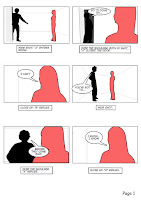 In this lesson, we were divided in 3 groups of 4, each one assigned to a particular job: 2 actors, 1 camera man and 1 director. We were set to film a short sequence following a script (a story board) that we were given to while choosing our own setting and create our own scene. We used the Sony NX5 as the camera and it produces really good quality shots.
In this lesson, we were divided in 3 groups of 4, each one assigned to a particular job: 2 actors, 1 camera man and 1 director. We were set to film a short sequence following a script (a story board) that we were given to while choosing our own setting and create our own scene. We used the Sony NX5 as the camera and it produces really good quality shots.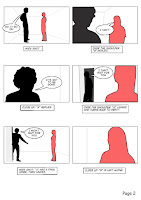 I was the director in this lesson. I learned the process that the director has to do before every shots is being filmed- for example: stand by, camera roll, action and cut. I also had to decide the angles for each shot to maximise the full effect of each scene. We also experimented to try and shoot outside the storyboard by trying to shoot little details such as footsteps or close up of the character typing and etc. I also made sure that we stuck to the 180 degrees rule to prevent the scene from being messy.
I was the director in this lesson. I learned the process that the director has to do before every shots is being filmed- for example: stand by, camera roll, action and cut. I also had to decide the angles for each shot to maximise the full effect of each scene. We also experimented to try and shoot outside the storyboard by trying to shoot little details such as footsteps or close up of the character typing and etc. I also made sure that we stuck to the 180 degrees rule to prevent the scene from being messy.Development for thriller opening sequence
Thriller elements- Suspense, tension, crime, mysteries, physical actions, fights, murders, unsolved events, scary, usually involve blood and violence.
Thriller movies- Kill Bill, The Purge, Dead Silence, Saw, Sherlock Holmes, Shawshank Redemption, The Dark Knight Rises, Fight Club, Shutter Island.
Plot of the opening sequence: A psycho serial killer wearing a scary clown mask walking towards his car while dragging a dead body, put the body in the trunk and drove off.
The walking scene could be a shot of his feet walking on the small pebble rocks which creates some really interesting sound- the camera moves along with the footsteps. The scene then slowly fade cut every time the shot changes. The second shot my show his hand holding on to someone's leg and slowly pan down to reveal a whole dead body. When the killer gets to the car, he open the trunk and throw the dead body inside. This shot could be done by putting the camera inside the trunk and when the body is inside and the killer closes the trunk, it blacks out. The killer then open the door and sit on the driving seat. He took off his mask. After that, he adjust the driving seat's mirror which only shows a corner of his eyes with a scar on his face. Blacks out.
All of this could be shot in our school, using the space of the lower carpark which gives the isolated- forest kind of feelings.
Thriller movies- Kill Bill, The Purge, Dead Silence, Saw, Sherlock Holmes, Shawshank Redemption, The Dark Knight Rises, Fight Club, Shutter Island.
Plot of the opening sequence: A psycho serial killer wearing a scary clown mask walking towards his car while dragging a dead body, put the body in the trunk and drove off.
The walking scene could be a shot of his feet walking on the small pebble rocks which creates some really interesting sound- the camera moves along with the footsteps. The scene then slowly fade cut every time the shot changes. The second shot my show his hand holding on to someone's leg and slowly pan down to reveal a whole dead body. When the killer gets to the car, he open the trunk and throw the dead body inside. This shot could be done by putting the camera inside the trunk and when the body is inside and the killer closes the trunk, it blacks out. The killer then open the door and sit on the driving seat. He took off his mask. After that, he adjust the driving seat's mirror which only shows a corner of his eyes with a scar on his face. Blacks out.
All of this could be shot in our school, using the space of the lower carpark which gives the isolated- forest kind of feelings.
Thursday, 15 October 2015
Thriller Sub-genres
Action Thriller
Crime Thriller
This type of thriller usually involve guns, violence and
explosions. Usually have aspects of crime and mystery,but usually set in a
limited space/one location. Plot usually involve a threat by enemy which is
then saved by one hero who fights his way through the film in order to defeat
the enemy.
Conspiracy Thriller
The character usually sees a secret about an organisation
and defeat them alone as nobody is on his side
Focuses on crime- either criminal or police's point of view.
The ending is usually about the criminal being arrested or the mystery being
unsolved by the detective.
Disaster Thriller
Usually about a natural disaster, the character tries to
stop the incident and save the world.
Eco-Thriller
The character tries to stop the environment being damaged-
the damage could be local or national depending on the plot.
Forensic Thriller
The characters are forensic scientists who needs to solve
mysteries in order to keep themselves from getting killed.
Legal Thriller
This usually takes place in a court room- the character coud
be a lawyer or victim who's trying to save someone's life or avoid being
killed.
Medical Thriller
Usually about viruses which were leaked by the doctors. The
main character is usually a doctor that tries to cure the disease.
Mystery Thriller
Involves mysteries and thrillers. Usually fast-paced and
involves unsolved accidents that the character must pursue.
Psychological Thriller
Involves conflicts in mental state not physical. Usually
involves a lot of psychopaths and problems inside the character's head that
challenges their sanity.
Religious Thriller
Uses myths and facts about religion in the history.
Romantic Thriller
Basically a thriller which involves a lot of actions and
fightings while creating a relationship between two characters.
Supernatural Thriller
Involves supernatural characters and powers which is not
likely to happen in realistic thrillers. Usually involves zombies or ghost in
the plot.
Techno-Thriller
Cross between futuristic science fiction and thriller.
Usually involves high-tech equipments as well as characters.
Tuesday, 6 October 2015
Studio Lesson- Editing
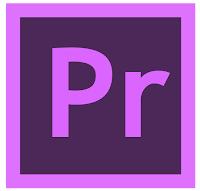
In this lesson, we were introduced to editing sequences using Adobe Premiere.
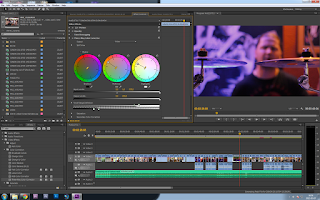 We learned how to cut, organize, duplicate and store files in their corresponding project bin. We edited the sequences we shot in lesson 2 and put them all into one continuous scene with many different angle shots. We were also showed the audio and video functions and how to use them effectively. We acquired the basics of editing skills in just one lesson which I think personally, is pretty amazing..
We learned how to cut, organize, duplicate and store files in their corresponding project bin. We edited the sequences we shot in lesson 2 and put them all into one continuous scene with many different angle shots. We were also showed the audio and video functions and how to use them effectively. We acquired the basics of editing skills in just one lesson which I think personally, is pretty amazing..Camera Shots, Angles and Movements
Camera Angles:
Establishing shots- to establish settings or scene to the audience.
Panning: Moving the camera lens from one part of the frame to the other.
Establishing shots- to establish settings or scene to the audience.
Extreme long shots- to show the surroundings in more detail of the character.
Long shots- a full body shot, used to see everything in the scene.
Mid long shots- usually from thigh upwards (American angle)
Mid shots- usually from waist upwards.
Close-up shots- sometimes include shoulder and face, used to focus details on character's face.
Extreme close-up shots- focusing on character's specific details.
High angle shots- status shot, used to make the character seems small and obedience.
Low angle shots- status shot, used to make audience feels inferior.
High vs Low shots- status shot, interchanging between high n low characters.
Point of view shots- shots from character's point of view.
Over the shoulder shots- shots from over the character's shoulders, usually used in conversations.
Canted angle shots- for the audience to feel disoriented and uneasy.
Camera Movement:
Panning: Moving the camera lens from one part of the frame to the other.
Zoom: Changing vocal length to make the subject in the frame appear closer or further away.
Tilt: Moving the camera up and down while keeping it constant horizontally.
Track: Moving the camera forward, backwards, left, right while keeping the focus on the subject.
Hand-held: Moving the camera in a more mobile movement to make the audience feels as if they were in the action of the scene.
Studio Lesson- Camera Introduction
In this studio lesson, we were introduced to 3 cameras and learned how to operate them as well as how to use the tripods and how to focus each shots in different distance/angles.
The 3 cameras were:
 Canon 5D- This camera has a fixed lens which means it cannot auto-focus and we focus by measuring the distance between the camera and the shot and adjust the lens to the appropriate distance in order for the lens to focus.
Canon 5D- This camera has a fixed lens which means it cannot auto-focus and we focus by measuring the distance between the camera and the shot and adjust the lens to the appropriate distance in order for the lens to focus.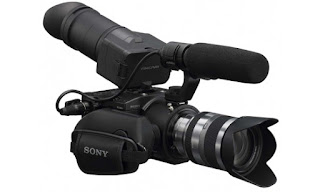
Sony FS100 - In order to focus with this camera, you need to zoom all the way into the shot, focus on that little spot and zoom out to the desire distance in order to make the whole scene focused.
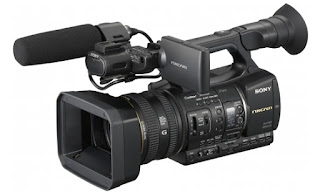
Sony NX5- This works similar with Sony FS100, in order to focus the shot, you need to zoom in and focus and zoom out to make the whole scene focused.
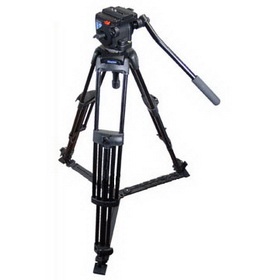
Vinten Tripod- The tripod is used to keep the camera in place as well as keep it steady throughout the scene. We can adjust the tripod to our desired height, place and lock the camera on top then bubble the tripod to make sure it is all balanced.
Subscribe to:
Comments (Atom)














